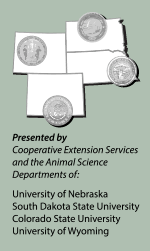Replacement Heifers
How many should I breed, and what are they worth?
LOVELAND, Colo. (Nov. 17, 2015) — “You’ve got to know when to hold ’em and know when to fold ’em,” said Ron Lemenager, “and know when to run.”

Ron Lemenager said one of the biggest challenges to making herd expansion decisions is accurately estimating future prices, not on the average, but on the day an input is purchased or an output is sold.
Referencing lyrics from Kenny Rogers' 1978 hit The Gambler, the Purdue University Extension beef specialist illustrated that cow-calf producers trying to decide what to do with replacement females may find it hard to know whether to hold or fold. Some might prefer to run away. In a presentation delivered at the 24th Range Beef Cow Symposium hosted Nov. 17-19 in Loveland, Colo., Lemenager admitted that it’s hard for him to answer producers’ questions about how many heifers to keep and what replacement females are worth. There are no easy answers.
According to Lemenager, one of the biggest challenges to making herd expansion decisions is accurately estimating future prices, not on the average, but on the day an input is purchased or an output is sold. It would take a magic crystal ball to reveal what prices will be for the next eight to 10 years for all feed resources, feeder calves, cull cows, equipment replacement and interest rates.
“Without accurate price forecasting, all we can do is create a number of possible scenarios using our best estimate of price ranges that seem possible for the most volatile components,” Lemenager said. “They may provide some insight that will stimulate the thought process for making the best informed decisions that result in optimizing long-term ranch profitability.”
Addressing the question of what replacement heifers are worth, Lemenager reminded his audience that perceived value often isn’t the same as real value. He recommended using computer software, like the Excel spreadsheet decision-making tool developed by Iowa State University, to calculate net present value for replacement females. Net present value reflects the value of potential future returns, in today’s dollars, based on an assumed rate of return.
“We use a net present value calculator to evaluate the difference between the revenue a heifer is expected to generate and her cost,” Lemenager explained. The software requires the user to make certain assumptions, plugging in the numbers representing:
- purchase price of replacement female (if any),
- number of calving opportunities,
- number of marketable calves,
- weaning weights of calves,
- sale prices of calves,
- annual cow costs,
- annual heifer development costs,
- weight of cow when culled,
- sale price of cull cow, and
- discount rate (interest).
Ranchers should use realistic numbers and conservative feeder-calf price projections to calculate net present value of retained or purchased replacement females, Lemenager said. The result, along with careful consideration of how much risk the ranch is willing to accept, should help producers determine whether this is an opportune time to keep extra heifers or delay expansion.
Editor’s Note: This summary was written under contract or by staff of the Angus Journal®, which retains the copyright. To request to reprint this article, contact Shauna Rose Hermel, editor, at 816-383-5270. PowerPoints are posted with permission of the presenter and may not be reproduced in whole or in part without the express permission of the presenter. Angus Journal claims copyright to this web site as presented. We welcome educational venues and cattlemen to link to this site as a service to their audience.
The Angus Journal's coverage of the event is made possible through collaboration with the event committee and sponsorship of LiveAuctions.tv. For questions about this site, or to notify us of broken links, click here. Look for additional coverage in the Angus Journal, the Angus Beef Bulletin, the Angus Journal Daily, the Angus Beef Bulletin EXTRA and Angus TV.


